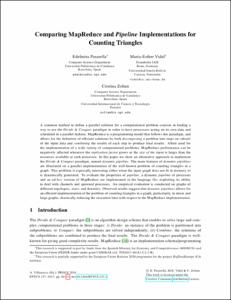Mostra el registre d'ítem simple
Comparing MapReduce and pipeline implementations for counting triangles
| dc.contributor.author | Pasarella Sánchez, Ana Edelmira |
| dc.contributor.author | Vidal, Maria-Esther |
| dc.contributor.author | Zoltan Torres, Ana Cristina |
| dc.contributor.other | Universitat Politècnica de Catalunya. Departament de Ciències de la Computació |
| dc.date.accessioned | 2017-01-26T11:13:06Z |
| dc.date.available | 2017-01-26T11:13:06Z |
| dc.date.issued | 2017-01-11 |
| dc.identifier.citation | Pasarella, E., Vidal, M., Zoltan, A. Comparing MapReduce and pipeline implementations for counting triangles. "Electronic proceedings in theoretical computer science", 11 Gener 2017, vol. 237, p. 20-33. |
| dc.identifier.issn | 2075-2180 |
| dc.identifier.uri | http://hdl.handle.net/2117/100102 |
| dc.description.abstract | A common method to define a parallel solution for a computational problem consists in finding a way to use the Divide and Conquer paradigm in order to have processors acting on its own data and scheduled in a parallel fashion. MapReduce is a programming model that follows this paradigm, and allows for the definition of efficient solutions by both decomposing a problem into steps on subsets of the input data and combining the results of each step to produce final results. Albeit used for the implementation of a wide variety of computational problems, MapReduce performance can be negatively affected whenever the replication factor grows or the size of the input is larger than the resources available at each processor. In this paper we show an alternative approach to implement the Divide and Conquer paradigm, named dynamic pipeline. The main features of dynamic pipelines are illustrated on a parallel implementation of the well-known problem of counting triangles in a graph. This problem is especially interesting either when the input graph does not fit in memory or is dynamically generated. To evaluate the properties of pipeline, a dynamic pipeline of processes and an ad-hoc version of MapReduce are implemented in the language Go, exploiting its ability to deal with channels and spawned processes. An empirical evaluation is conducted on graphs of different topologies, sizes, and densities. Observed results suggest that dynamic pipelines allows for an efficient implementation of the problem of counting triangles in a graph, particularly, in dense and large graphs, drastically reducing the execution time with respect to the MapReduce implementation. |
| dc.format.extent | 14 p. |
| dc.language.iso | eng |
| dc.rights.uri | http://creativecommons.org/licenses/by/3.0/es/ |
| dc.subject | Àrees temàtiques de la UPC::Informàtica::Informàtica teòrica |
| dc.subject.lcsh | Parallel programming (Computer science) |
| dc.subject.other | MapReduce |
| dc.subject.other | Dynamic pipeline |
| dc.subject.other | Counting triangles |
| dc.subject.other | Parallelism |
| dc.title | Comparing MapReduce and pipeline implementations for counting triangles |
| dc.type | Article |
| dc.subject.lemac | Programació en paral·lel (Informàtica) |
| dc.contributor.group | Universitat Politècnica de Catalunya. ALBCOM - Algorismia, Bioinformàtica, Complexitat i Mètodes Formals |
| dc.identifier.doi | 10.4204/EPTCS.237.2 |
| dc.description.peerreviewed | Peer Reviewed |
| dc.relation.publisherversion | http://eptcs.web.cse.unsw.edu.au/content.cgi?PROLE2016 |
| dc.rights.access | Open Access |
| local.identifier.drac | 19526798 |
| dc.description.version | Postprint (published version) |
| dc.relation.projectid | info:eu-repo/grantAgreement/MINECO//TIN2013-46181-C2-1-R/ES/MODELOS Y METODOS COMPUTACIONALES PARA DATOS MASIVOS ESTRUCTURADOS/ |
| local.citation.author | Pasarella, E.; Vidal, M.; Zoltan, A. |
| local.citation.publicationName | Electronic proceedings in theoretical computer science |
| local.citation.volume | 237 |
| local.citation.startingPage | 20 |
| local.citation.endingPage | 33 |
Fitxers d'aquest items
Aquest ítem apareix a les col·leccions següents
-
Articles de revista [1.049]
-
Articles de revista [274]


